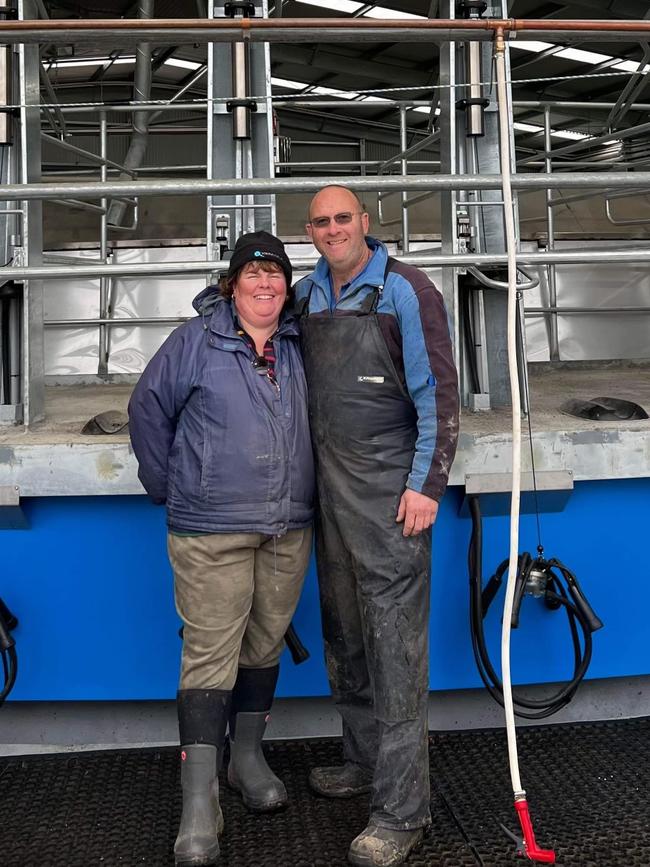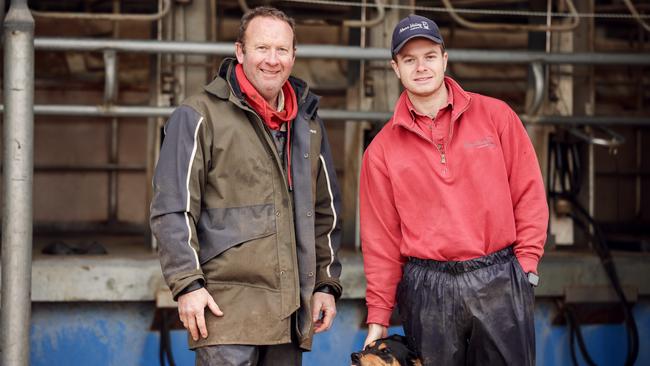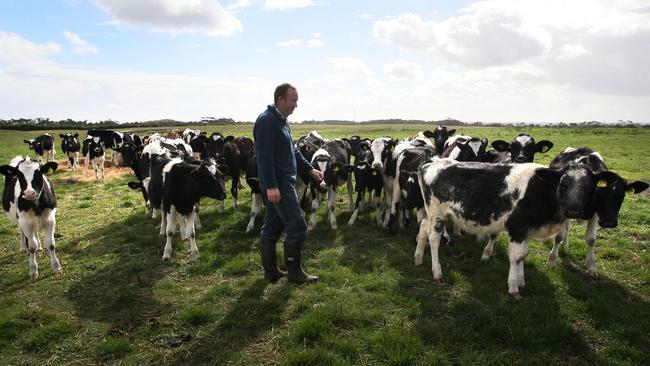Simone and Nick Renyard on their almost three decades in dairy farming
Simone and Nick Renyard have long been ambassadors for dairy. But what makes their southwest Victorian farm tick?
Simone and Nick Renyard from Curdievale have been assiduous ambassadors for dairy for decades — not just locally, but on the national industry scene too.
“We are always on the lookout for opportunities that may fit into the future direction of the business,” Simone said.
“We are passionate about our industry but aren’t looking to diversify at this stage.
“We are not interested in expanding just for the sake of expansion. Having a model that is sustainable and profitable is far more important to us.”
Simone has served as WestVic Dairy chairperson while Nick has held board and advocacy roles with the United Dairyfarmers of Victoria, Australian Dairy Farmers as well as the Corangamite Catchment Management Authority.
Their Curdievale dairy farm, Meon Valley, a short drive from dairy hub Timboon, boasts 600 cattle, mostly Holsteins, with a number of three-way crosses as well.

The Renyards own a main farm of 390ha, along with a neighbouring small lease block of 30ha, plus a further 43ha on the edge of Timboon where Nick’s parents live and run some of the young stock.
They’ve been farming as a couple since 1997 – Simone is a first generation farmer and Nick, at least a third generation farmer.
“The home block was bought in the late 1960s by my grandparents then my parents added more in 1973, 1988 and 2002,” Nick said.
“We then added to it in 2011 and 2016.
“The farm is mostly gently undulating with us being able to safely drive over nearly all of it. “The lease areas do have some very steep areas more suited to mountain goats!”
Nick’s parents John and Heather came from farming backgrounds and handed a love of the land onto their son.
He has in turn handed that onto his son, William. While their daughter Laura isn’t involved in the Curdievale business, she is actively involved in farming through agribanking and lives regionally in northern Victoria.
Alongside the Renyards, Meon Valley has two other full time and one part time team members.

CATTLE HEALTH
“Last year, the cows produced around 600kg milk solids, this has steadily increased over the years as we look for profitable ways to do so,” Simone said.
“Cell counts have dropped significantly over our time farming, because of this we have been able to move to selective dry cow therapy which has brought significant savings in antibiotic use.”
Keeping an eye on cattle health has paid dividends for the Renyards.
“Over the last decade per cow production has lifted by about 20 per cent,” Simone says.
“The lift in production has largely come from improved transition feeding and better management of cow condition. This has brought with it a healthier return on investment.
“We will never be satisfied with our return on investment and are always looking at areas for improvement.”
The districts around Curdievale – such as Nirranda, Timboon and Peterborough – are arguably some of the best for rainfall in Victoria.
While other parts of southwest Victoria were experiencing green drought by autumn, the area surrounding Meon Valley was still experiencing some grass growth.
But conditions changed over winter into spring.
“The rainfall averages 893mm and in our 54 years of daily rainfall records has varied between 636mm in 2006 and 1117mm in 2010,” Nick said.
“This year is definitely one of our driest years farming, with 441.6mm to the end of September. That said, we did get good April rain which gave us a decent start and has set us up for a reasonable year for growing grass.
“The La Niña years were very good for us even though winters became a bit more difficult.”
Nick said the farm hasn’t endured the extremes of temperature in the past few years, despite the drier season this year.
“As a child I seem to remember getting 40C-plus a few days every summer, something we haven’t had for the last few years,” he said.
“I also remember seeing a few small snowfalls here, something that hasn’t happened here for a long time.”
With the picturesque Curdies River not far from the farm, Meon Valley lives up to its name with undulating pastures.
“Parts of the farm are a very light sand and are well suited to wet winters,” Simone said.
“As we move across the farm they turn into loamy sand then to sandy loams as we move to some of the lower areas.
“The generally free draining nature of the soil means that we need to apply a number of fertiliser applications throughout the year to maintain soil fertility.”

PASTURE DRIVES
The Meon Valley farm is split into 92 paddocks, with most between 3.5ha and 5ha.
“Will is mostly looking after the paddock rotation with he and I doing regular pasture drives to frequently assess paddocks and growth rates,” Nick said.
“Will puts his ‘pastures for profits’ skills to use allocating an appropriate amount of grass to the cows and then either adding supplements or shutting up paddocks to conserve feed.”
When it comes to pasture on the Meon Valley farm, most paddocks are perennial rye-grass with some annuals too.
“We’ve had some trouble holding perennials in the light sand so we are trying out some cocksfoot, something which has held on fairly well in the past,” Simone said.
“We do grow about 16ha of maize each summer which makes very good use of our dairy effluent.
“We buy hay mostly for dry cows and pre-calving cows. We also do feed some to milking cows. The amounts vary depending on the type of season we are having.
“We try to be proactive with our hay buying to ensure we have what we need well before we need to feed it.”
Stock and dairy water is supplied from a number of bores.
“Most paddocks have two inch water lines, every paddock has at least one trough and we are working to get more paddocks where cows can access two troughs,” Nick said.
“There is a very small irrigation allocation which goes on the maize if the dam fills.”
RIGHT TIMING
Investment in vegetation and faunal biodiversity has been a long-term vision for the southwest Victorian farmers.
“There’s around 8ha of remnant vegetation fenced off with stock permanently excluded,” Simone said.
“We have planted 4-5ha of shelter belts many years ago and recently participated in the Heytesbury District Landcare Network Biofund project in which we re-fenced an existing piece of remnant vegetation and widened the riparian zone around an intermittent waterway.”
Like many dairy farmers, Simone and Nick said their three biggest costs are fertiliser, supplementary feed and employed labour.
“When buying in feed we endeavour to buy competitively priced feed while maintaining good relationships with our suppliers,” Simone said.
“Good relationships and timing are integral to success. Our fertiliser decisions are guided by our soil testing program and are timed to yield the best results.
“We value our team highly and we pride ourselves on systems and processes that aim for a mix between working smartly and effectively while allowing for a good work/life balance.”
Balancing the books and getting the timing right is also the key for longevity in dairy.
“We do an annual budget with monthly updates,” Nick said.
“We work with a farm consultant as we believe a set of independent eyes is beneficial to our business.
“We’ve always milked twice a day with those times moving forward an hour each end of the day about 20 years ago. This was important to allow our team to get home in good time each night.”
Artificial insemination has been used on the Renyard herd since the early 1970s, but like many farmers, Simone, Nick and their team keep a close eye on technological developments.
“We started to AI heifers eight to 10 years ago with a fixed time AI program and using sexed semen,” Simone said.
“Cows are mostly joined to natural heats as detected by our HeatTime collar system although we do use a program where we identify cows that are not cycling.”
STILL OPTIMISTIC
Dairy farmgate prices have been rising high in recent seasons, edging close to the $10 per kilo milk solids mark. But with an average of $8.20-$8.30 per kilo milk solids across much of Victoria, profitability this season is not what it once was.
“We’ve been with Bega for about three and a half years, since they acquired Lion Dairy and Drinks,” Simone says.
“Like most farmers, we made our decision around price but we are somewhat pleased to be able to supply an Australian company.
“As a farmer we always want that bit more as expenses never get any less and without a solid margin it becomes very difficult to continue to invest back in the business.
“The last couple of years have seen many farmers invest while margins have been good.”
Witnessing the highs and lows of a dramatic decade in dairy, Simone and Nick said they remain optimistic about the future of the sector.
“We find it very encouraging that a good crop of young people are coming through and seem eager to grow their dairy careers,” Simone said.
“Watching the landscape over the next few years will be very interesting as we are already seeing processor attitudes to pricing manifest in farmers confidence to invest.
“With reduced confidence in future pricing, farmers end up being more conservative in their investment decisions. “





